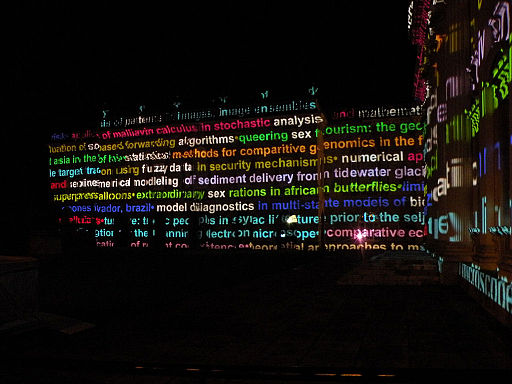Category: Anthropology
Liveblogging, Fans, & Learning on Tumblr

Here I talk USWNT fans, multimodal communication, liveblogging, and active moments of learning unfolding in a potentially asynchronous manner on Tumblr in my presentation from NASSS 2013 in Quebec City.
More to follow – a quick review of my posts shows I’m missing FOUR of my presentations on my ethnographic research from the last year. YIKES! #mustcatchup
Until then, have a look at my presentation from November’s North American Society for the Sociology of Sport presentation titled “You Must Be New: Becoming Fans & Communicating Values While Defining International Sport Online.” The presentation unpacks the USWNTvCANWNT rivalry that swelled in the final few minutes of the 03 June 2013 fixture between the two teams. Dubbed “The Rematch,” passions were high for fans of both teams – and dual-nationality player Sydney Leroux’s overtime goal lit the powder keg of incendiary debate that followed.
This discussion focused on the collective fiery learning moment, but future discussion will unpack the racialized and gendered discourses in which Leroux was suspended – with emphasis on nation/nationality, assertions of racism and racist chants, the mediated lens of professional sport, and narrative content – and, of course, being “classy” as an athlete and as fans in-person vs online consumption of sport. Watch this space…
Between the Sporting Lines

Happy New Year and third week in January! There’s already so much happening this year that I’ve not had a chance to share these slides from a talk I gave in December for a Foreign Services Institute panel on Sport in Western Europe.
Our panel was oriented around the challenges and experiences foreign service professionals might face as they enter their next assignments. I spoke with the group to recommend a set of questions that could be used to analyze the social and political circumstances of their environments – rather than an overview of any one aspect of sport or region in Western Europe.
I described my presentation as “talking a bit about the ways sport can be a lens to better understand the communities in which the students will be situated; that includes thinking about the origins and functions of sporting clubs (as it contrasts with U.S. sport models) — and how a keeping an ear to media coverage of sport can tell more about the readership than the sport/event itself. I suppose I’d call my remarks a series of critical questions the students can take forward and more rapidly relate to the context of their assignments.”
While I can’t be sure whether the group felt immediate resonance with my presentation, much like teaching a research methods or theory course, I do hope these questions will be triggered in interactions in the future – leading to better integration and understanding of host cultures.
What kinds of questions would you include in unpacking the meaning, impact, and role of sport if you found yourself in a new city or country? Please share your thoughts or relevant resources in the comments.
The Economist on Anthropology & Adidas
Last month, The Economist profiled ReD, the design research company that uses anthropologists and researchers to deliver insights for Adidas product and brand development.
ReD Associates, the Copenhagen and NYC-based researching firm, has used a unique combination of ethnographic and applied social science research coupled with business market analysis to inform robust brand development. The Economist article deftly explains the ways in which anthropologists tap into the heart of complex relationships and hidden meanings through participant observation and specific-but-unexpected questions.
What I admire about this company is the way they encourage their researchers (according to the article and their own brand identity materials) to ask different kinds of questions to derive actionable insights. They very accurately describe the complexity of fieldwork and how work in the “messy” environments of people’s lives, emotions, and work results in realistic (and sometimes askew or counter-intuitive) understanding of behavior and belief: they say “we look at people holistically in their environments.”
The kinds of questions that are suggested in the Economist article actually relate to unspoken personal and shared beliefs and tell as much about the cultures in which these people live as their likely brand affiliation and consumer behaviors.
There are five design research tasks described in the article; three relate to collective beliefs. Two of those collective beliefs relate to national identities and collective representation – and their findings linked to traditions and moments of sporting national pride that relate to scientific and political successes (in the U.K. and Russia). These are really fascinating discoveries about collectivity and the ways in which shared cultural history can inform, frame, and sometimes even inhibit brand relationships.
The types of questions we anthropologists might ask in a research environment–or indeed in a social setting–might not immediately make sense or seem to relate to objectives. Why would understanding what would make a great footballer in the future be helpful for improving performance technologies today? Why would knowing that fitness for body composition is as important as sporting prowess for some consumers be useful? These are anthropological ways of investigating and accessing aspirational qualities associated with the values and products of the brands that create outstanding consumer experiences.
If you’re looking for actionable insights through ethnography and grounded research methods, please get in touch – and if you’re an anthropologist, keep turning that rock!
RDR on 10 Distinctive Qualities of Qualitative Research
Research Design Review recently summarized 10 distinctive qualities of qualitative research which succinctly capture the essence and utility of the kind of work performed by researchers like me.
In her Research Design Review piece, author Margaret Roller observes that qualitative research happens because researchers “acknowledge the human condition and want to learn more, and think differently, about a research issue than what is usual from mostly numerical quantitative survey research data.”
Below are Roller’s 10 attributes (in bold) and the reasons I consider them useful.
- Absence of “truth”
- As suggested on this blog regularly, knowledge is constructed from information and in context. It is the the product of the process of research; it is not truth but rather “possibility” (plausible interpretation). I often describe my findings or interpretations as “ONE truth” or “one version of truth/reality,” emphasizing that my interpretation is well-informed but always subject to negotiation based on further context
- Importance of context
- The setting, culture, research parameters and questions always influence the ways in which we can interpret data.
- Importance of meaning
- Meaning is created through understanding the blooms from the intersections of many points in analysis. Roller suggests sources for meaning include “any number of variables such as: the context, the language, the impact of the participant-researcher relationship, the potential for participant bias, and the potential for researcher bias.”
- Researcher-as-instrument
- The interpretations and the process of research are performed through and organized by and described through the researcher. This has many benefits including the potential for nuanced findings and “thick description” but it is also important to consider the bias, approaches, and institutional contexts of the researcher – as well as the power the researcher wields as an instrument of qualitative analysis. Remember, many choices, and therefore the exercise of power, play a role in final interpretations.
- Participant-researcher relationship
- This is element of qualitative research is extremely important in performing and getting useful and accurate interpretations. Communication, rapport, and accountability all play a role in a successful participant-researcher relationship and shape the outcomes of data collection and analysis.
- Skill set required of the researcher
- Perhaps the most underrated of these qualities, qualitative research “requires a unique set of skills from the researcher, skills that go beyond the usual qualities of organization, attention to detail, and analytical abilities that are necessary for all researchers,” Roller observes. She goes on to list rapport-building and active listening as further examples, but her most notable point is that specific and nuanced analytical toolkit is necessary to “meet the demands of “messy analysis” (see below) in qualitative inquiry where context, social interaction, and numerous other inter-connected variables contribute to the realities researchers take away from the field.” This is often the most difficult thing to explain when entering a project but often unfolds without stakeholders realizing. If it’s a smooth researching process with audiences, you’ve likely brought on board a skilled researcher.
- Flexibility of the research design
- Again, an extremely complicated skill to bullet point on a resume. Yet, a flexible researcher knows how to stay active and continue to derive communication while simultaneously analysing the information; second and third passes over the data will allow for even more robust findings. In other words, the intended questions may be set aside to capture the reality of the researching space and research may take iterations to flesh out hidden meanings and perspectives.
- Types of issues or questions effectively addressed by qualitative research
- Especially for questions that really mean “to what extent” rather than “how much” or seeking to understand group behaviors and cultural values that emerge concurrently with or contradict official/dominant perspectives.
- Messy analysis and inductive approach
- Qualitative research may start with a general question and create understanding as knowledge is being attained. Roller writes “without a doubt, qualitative research analysis is messy. The analysis of qualitative data does not follow a straight line, where point ‘A’ leads to point ‘B’, but rather is a multi-layered, involved process that continually builds upon itself until a meaningful and verifiable interpretation is achieved. The messiness of the interconnections, inconsistencies, and seemingly illogical input reaped in qualitative research demand that researchers embrace the tangles of their data from many sources. A large contributor to the “messiness” of the analytical process is the inductive method. Qualitative researchers analyze their outcomes from the inside out, organizing and deriving meaning from the data by way of the data itself.“
- Unique capabilities of online and mobile qualitative research
- Finally, technology allows for new techniques AND new research spaces – and supports general communication and connection (and conflict!) between groups of people. The resulting research space, as Roller suggests, offers new power dynamics between researcher and participants but also offers shared control of findings and more flexible ways to gather, respond, organize and distribute research findings.
Qualitative research is excellent for unlocking detailed case studies, understanding communication and communities, and understanding audiences and every day lives, as well as helping flush out and answer the assumptions and further questions that often emerge in quantitative analyses.
DANG: It’s on in Chicago

Last week, I received confirmation that the Digital Anthropology group – DANG – panel was accepted for the American Anthropological Association 2013 Conference. As a reminder, I’ll be discussing the necessity of conflict in refining the values and goals of a fandom online. My paper (presentation) is titled “It boils down to respect”: Defining the values of a fandom through conflict online.
My abstract begins: “Increasingly, social media allows users to connect their online behaviors to physical practices in pursuit of collective goals. In these digital public spaces, communities of practice are able to bypass geographic and temporal boundaries. For U.S. Women National soccer team (USWNT) fans, Tumblr offers a digital realm in which multimodal communication unfolds – and quite often, conflict arises. Through online ethnography and discourse analysis, this study examines conflict as essential to refining USWNT fandom values; however, conflict also jeopardizes the participatory practices that define the fandom.”
The presentation is limited in time (15 min!!), which means a very focused and limited scope of discussion. I anticipate presenting a version of the discussion I have already prepared – focusing on the specific ways in which the fandom policies the “USWNT” tag and reinforces attribution or “sources.” These activities are borne out through messaging, anonymous posts, and text posts in the tag. These are really significant moments of productive conflict and help articulate group-defined “appropriate” behavior. Yet these conflicts also threaten archiving and sharing habits; spoiler alert: some fans refuse to continue to share, while others stop using tags which are used to refresh fan knowledge. Therefore, a delicate balance of conflict must be maintained, as too much discord threatens to dry one data stream through which fandom knowledge is developed.
I’ll share more of my preparations closer to November. Get in touch if you are heading to Chicago for AAA 2013, too –
Windy City, here we come!
